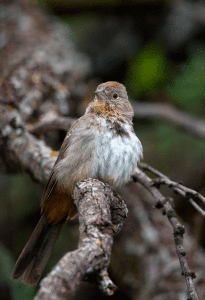
A Canyon Towhee fluffs up its feathers to trap warm air close to its body. Photo by Mike Williams
In this part of Texas, we can generally wear shorts in the winter. But there have been a few cold spells lately that have forced me to bundle up when I go outside. This got me thinking: how do animals, especially birds, keep warm in cold weather?
Birds have several adaptations that help them survive the winter in relative comfort. One of the most obvious ones is their downy feathers. Humans use down feathers to make warm coats and other clothing, so it makes sense that down serves the same warming purpose for birds. Down feathers are fluffy, small, and can be found down below the bird’s other feathers, close to the skin.
The fluffy down traps warm air next to the skin, insulating it against the cold outside. Birds can multiply this effect by fluffing up their feathers to create more pockets for warm air. If you see a particularly round bird this winter, it hasn’t eaten a baseball, it’s just fluffing up to keep warm.
Another source of insulation is fat. Birds who will need extra padding or energy are able to store fat reserves on their body. Before long flights or cold winters, birds will bulk up and eat even more food than usual. The fat reserves provide an additional layer between their core and the cold weather, plus more energy to create body heat.
But what about those parts of the body that don’t have much fat or feathers, particularly the legs? Birds lose vital body heat as warm blood circulates through their exposed legs, cooling as it goes. They can combat this problem by tucking their legs in close to their body to keep them warm, and with what’s called countercurrent heat exchange.
Warm blood enters the legs through arteries. Cooler blood exits the legs through veins. With countercurrent heat exchange, the birds have adapted to have arteries that touch the veins in the legs. This transfers heat from the blood coming into the legs to the blood exiting. It keeps more warmth in the body core and less heat enters the legs and feet to be leeched out by the cold.
Another cold weather adaptation can be found in a bird’s metabolism. Birds generally have a high metabolism and run a body temperature slightly higher than ours, about 105 degrees Fahrenheit. This internal temperature helps them keep warm in the winter, especially with those downy feathers and fat reserves keeping the heat in.
Finally, there are several behaviors that birds can practice to stay warm. If they have a flock, they can roost together, standing or sitting close to each other to keep the heat in. Those birds in the center of the group will be nice and toasty when they’re surrounded by down and 105 degree bodies! Another beneficial behavior is sunning. When the sun comes out, birds sit out and soak up the rays, saving their energy to make more heat when the clouds roll in.
So the next time you go outside and shiver, don’t worry about our downy feathered friends. With all of these awesome adaptations, they’re far better equipped for the winter than we are!
